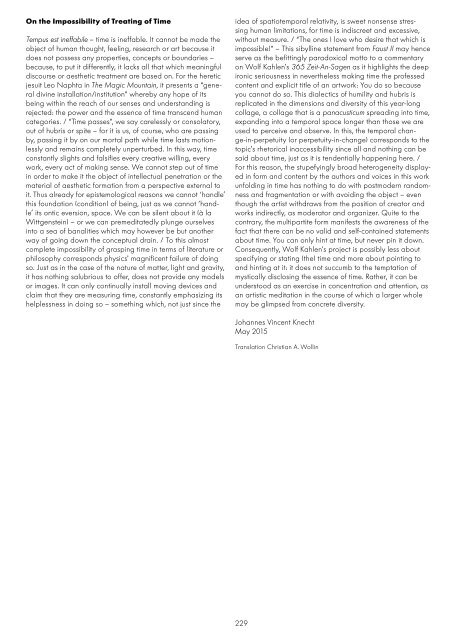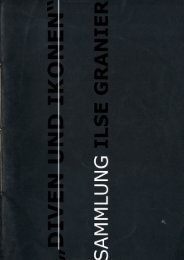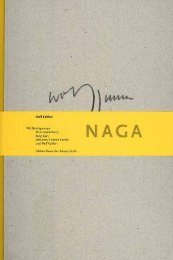Sie wollen auch ein ePaper? Erhöhen Sie die Reichweite Ihrer Titel.
YUMPU macht aus Druck-PDFs automatisch weboptimierte ePaper, die Google liebt.
On the Impossibility of Treating of Time<br />
Tempus est ineffabile – time is ineffable. It cannot be made the<br />
object of human thought, feeling, research or art because it<br />
does not possess any properties, concepts or boundaries –<br />
because, to put it differently, it lacks all that which meaningful<br />
discourse or aesthetic treatment are based on. For the heretic<br />
jesuit Leo Naphta in The Magic Mountain, it presents a “general<br />
divine installation/institution” whereby any hope of its<br />
being within the reach of our senses and understanding is<br />
rejected: the power and the essence of time transcend human<br />
categories. / “Time passes”, we say carelessly or consolatory,<br />
out of hubris or spite – for it is us, of course, who are passing<br />
by, passing it by on our mortal path while time lasts motionlessly<br />
and remains completely unperturbed. In this way, time<br />
constantly slights and falsifies every creative willing, every<br />
work, every act of making sense. We cannot step out of time<br />
in order to make it the object of intellectual penetration or the<br />
material of aesthetic formation from a perspective external to<br />
it. Thus already for epistemological reasons we cannot ‘handle ,<br />
this foundation (condition) of being, just as we cannot ‘handle<br />
, its ontic eversion, space. We can be silent about it (à la<br />
Wittgenstein) – or we can premeditatedly plunge ourselves<br />
into a sea of banalities which may however be but another<br />
way of going down the conceptual drain. / To this almost<br />
complete impossibility of grasping time in terms of literature or<br />
philosophy corresponds physics’ magnificent failure of doing<br />
so. Just as in the case of the nature of matter, light and gravity,<br />
it has nothing salubrious to offer, does not provide any models<br />
or images. It can only continually install moving devices and<br />
claim that they are measuring time, constantly emphasizing its<br />
helplessness in doing so – something which, not just since the<br />
idea of spatiotemporal relativity, is sweet nonsense stressing<br />
human limitations, for time is indiscreet and excessive,<br />
without measure. / “The ones I love who desire that which is<br />
impossible!” – This sibylline statement from Faust II may hence<br />
serve as the befittingly paradoxical motto to a commentary<br />
on Wolf Kahlen’s 365 Zeit-An-Sagen as it highlights the deep<br />
ironic seriousness in nevertheless making time the professed<br />
content and explicit title of an artwork: You do so because<br />
you cannot do so. This dialectics of humility and hubris is<br />
replicated in the dimensions and diversity of this year-long<br />
collage, a collage that is a panacusticum spreading into time,<br />
expanding into a temporal space longer than those we are<br />
used to perceive and observe. In this, the temporal change-in-perpetuity<br />
(or perpetuity-in-change) corresponds to the<br />
topic’s rhetorical inaccessibility since all and nothing can be<br />
said about time, just as it is tendentially happening here. /<br />
For this reason, the stupefyingly broad heterogeneity displayed<br />
in form and content by the authors and voices in this work<br />
unfolding in time has nothing to do with postmodern randomness<br />
and fragmentation or with avoiding the object – even<br />
though the artist withdraws from the position of creator and<br />
works indirectly, as moderator and organizer. Quite to the<br />
contrary, the multipartite form manifests the awareness of the<br />
fact that there can be no valid and self-contained statements<br />
about time. You can only hint at time, but never pin it down.<br />
Consequently, Wolf Kahlen’s project is possibly less about<br />
specifying or stating (the) time and more about pointing to<br />
and hinting at it: it does not succumb to the temptation of<br />
mystically disclosing the essence of time. Rather, it can be<br />
understood as an exercise in concentration and attention, as<br />
an artistic meditation in the course of which a larger whole<br />
may be glimpsed from concrete diversity.<br />
Johannes Vincent Knecht<br />
May 2015<br />
Translation Christian A. Wollin<br />
229








